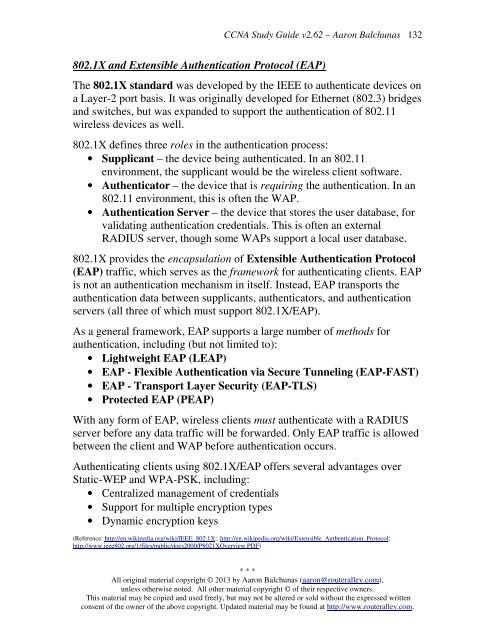Cisco CCNA Study Guide - Router Alley
Cisco CCNA Study Guide - Router Alley
Cisco CCNA Study Guide - Router Alley
Create successful ePaper yourself
Turn your PDF publications into a flip-book with our unique Google optimized e-Paper software.
<strong>CCNA</strong> <strong>Study</strong> <strong>Guide</strong> v2.62 – Aaron Balchunas<br />
132<br />
802.1X and Extensible Authentication Protocol (EAP)<br />
The 802.1X standard was developed by the IEEE to authenticate devices on<br />
a Layer-2 port basis. It was originally developed for Ethernet (802.3) bridges<br />
and switches, but was expanded to support the authentication of 802.11<br />
wireless devices as well.<br />
802.1X defines three roles in the authentication process:<br />
• Supplicant – the device being authenticated. In an 802.11<br />
environment, the supplicant would be the wireless client software.<br />
• Authenticator – the device that is requiring the authentication. In an<br />
802.11 environment, this is often the WAP.<br />
• Authentication Server – the device that stores the user database, for<br />
validating authentication credentials. This is often an external<br />
RADIUS server, though some WAPs support a local user database.<br />
802.1X provides the encapsulation of Extensible Authentication Protocol<br />
(EAP) traffic, which serves as the framework for authenticating clients. EAP<br />
is not an authentication mechanism in itself. Instead, EAP transports the<br />
authentication data between supplicants, authenticators, and authentication<br />
servers (all three of which must support 802.1X/EAP).<br />
As a general framework, EAP supports a large number of methods for<br />
authentication, including (but not limited to):<br />
• Lightweight EAP (LEAP)<br />
• EAP - Flexible Authentication via Secure Tunneling (EAP-FAST)<br />
• EAP - Transport Layer Security (EAP-TLS)<br />
• Protected EAP (PEAP)<br />
With any form of EAP, wireless clients must authenticate with a RADIUS<br />
server before any data traffic will be forwarded. Only EAP traffic is allowed<br />
between the client and WAP before authentication occurs.<br />
Authenticating clients using 802.1X/EAP offers several advantages over<br />
Static-WEP and WPA-PSK, including:<br />
• Centralized management of credentials<br />
• Support for multiple encryption types<br />
• Dynamic encryption keys<br />
(Reference: http://en.wikipedia.org/wiki/IEEE_802.1X; http://en.wikipedia.org/wiki/Extensible_Authentication_Protocol;<br />
http://www.ieee802.org/1/files/public/docs2000/P8021XOverview.PDF)<br />
* * *<br />
All original material copyright © 2013 by Aaron Balchunas (aaron@routeralley.com),<br />
unless otherwise noted. All other material copyright © of their respective owners.<br />
This material may be copied and used freely, but may not be altered or sold without the expressed written<br />
consent of the owner of the above copyright. Updated material may be found at http://www.routeralley.com.
















